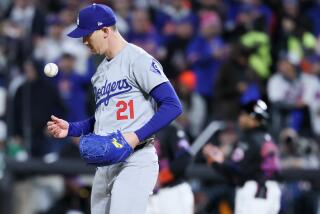ART REVIEW : Huebler Adds Words to His Varied Palette
- Share via
LA JOLLA — Words are all over the place in Douglas Huebler’s exhibition at the La Jolla Museum of Contemporary Art, and we’re not just talking labels.
A tiny skywriting plane puffs out the peaceable kingdom in the sunset of a romantic landscape painting. It’s a wonderfully funny image that puts the title of Edward Hicks’ primitive masterpiece into an exalted form of 20th-Century advertising and tacks it onto an archetypal example of 19th-Century painting.
This glowing example of irreverence stands alone as the catalogue frontispiece. When it turns up in the show, it has acquired yet another layer of meaning related to a argument over feeding birds and squirrels in one of Huebler’s conceptual comic strips.
Words proliferate in other strips that read like art-world soap operas. At the end of each episode a sentence or two lends a mock analytical tone by grouping people in cliched categories: “Represented above is at least one person who is slicker than a greased pig,” “. . . who always seems to be swimming upstream” or “. . . who can smell trouble a mile away.”
Speaking more ponderously, a painting that extends over the entire wall of the museum’s lobby incorporates text explaining (in part) that the big blue rectangle on the right isn’t just a mass of color but the culmination of vertical blue lines painted at decreasing intervals. Eventually this progression breaks down “conceptual order into commonplace illusionism.”
This is definitely a show to be read, but the most important words may be overlooked because they are printed on a simple panel. They compose an outrageous declaration of intent, issued in 1971: “Throughout the remainder of the artist’s lifetime he will photographically document, to the extent of his capacity, the existence of everyone alive in order to produce the most authentic and inclusive representation of the human species that may be assembled in that manner.”
Huebler is no zealous accountant, but much of his subsequent work can be traced to that statement. In the current show, concentrating on his work of the ‘80s, you won’t find row upon row of photographic portraits, in the manner of August Sander, or crowd scenes that represent an effort to round up great gobs of the world’s population and thus dispense with the project.
It isn’t the mechanics or the impossible chore of photographing “everyone alive” that shapes this work; it’s the democratic (if patently absurd) idea of recognizing everyone in a single oeuvre-- while not promising Warhol’s 15 minutes of fame to anyone.
The people who turn up in Huebler’s story boards and multipart wall works usually appear banal. What’s interesting about their blurry faces and obscure figures is not their individuality but their conformance to patterns of behavior, experience or appearance. At times Huebler almost convinces us that he could achieve his goal, for to photograph a few of these ordinary people is to photograph all of us.
The notion that he takes the whole world as his subject is a conceit, however. Despite his anti-elite approach, most of Huebler’s work at La Jolla is art-about-art or art-about-the-art-world. The hero of his screenplay and story boards, called “Crocodile Tears” (a name also used for his comics), is a performance artist who plays computer games on a precarious seat above a swimming pool swarming with crocodiles.
Among the leading men in his comic strips are a young medical illustrator who grows up to be a “corrector” of famous artworks, a “signature” artist whose buddy counsels him against cranking out variations of the same old painting and a dealer who commissions fakes to satisfy the appetites of wealthy clients. Ethical issues run through these humorous tales like the evil forces that threaten to defeat the Lone Ranger.
These themes turn up again in wall works combining the comics’ text with unrelated photographs of people and a replication of a famous painting. For his “Buried Treasure” series, incorporating text about the unscrupulous dealer, Huebler paints fake Monets and Picassos, Van Goghs, Gauguins and a De Chirico. In “The Great Corrector” series, he “corrects” the faults of Mondrian, Matisse, Cezanne and Rothko. Huebler’s task is particularly ludicrous when he tackles a solid black canvas by Ad Reinhardt.
As a conceptualist, Huebler goes to a lot of trouble to produce artistic objects, but he does so to buttress ideas.
The irreverent act of painting a fake or an “improved” masterpiece and hanging it in a museum is in keeping with the current fashion for debunking the concept of originality. But that’s far from the only point of this exhibition.
Huebler is an observant veteran who absorbed ‘60s Pop art in his comics and populist strategy. The subsequent hegemony of Minimalism--with its insistence on pure, “self-referential” form--surely influenced his non-objective wall paintings and attendant text, but the essential Huebler still seems most concerned with the ways that “worldly matters” appear in art, how they affect its production and our perception.
A catalogue essay emphasizes his efforts to unload the baggage we bring to art. He doesn’t succeed in “stripping away preconceptions” any more than he manages to photograph “everyone alive,” but amid all the words are some very important questions.
The exhibition continues through Aug. 7.
More to Read
The biggest entertainment stories
Get our big stories about Hollywood, film, television, music, arts, culture and more right in your inbox as soon as they publish.
You may occasionally receive promotional content from the Los Angeles Times.










